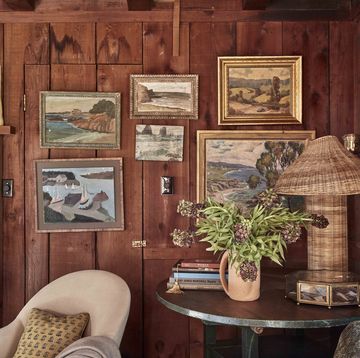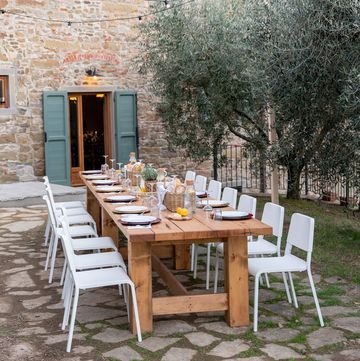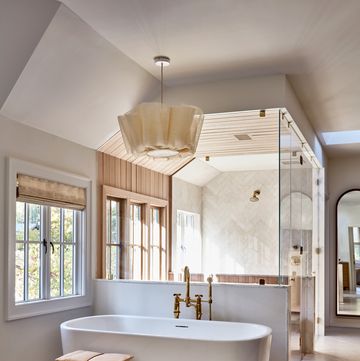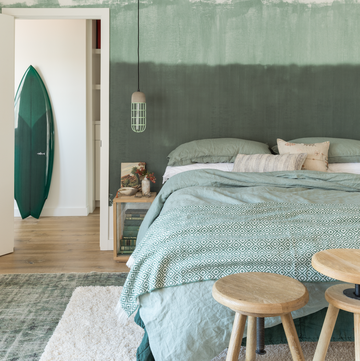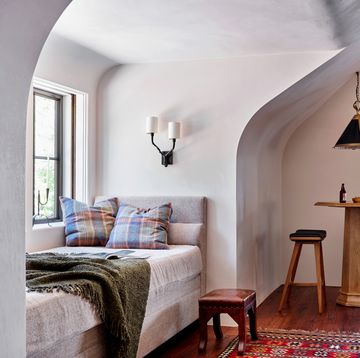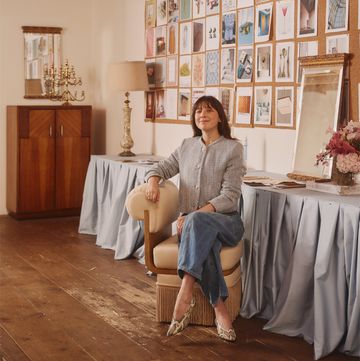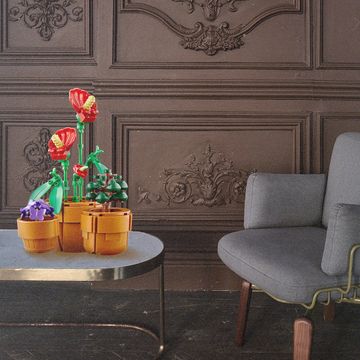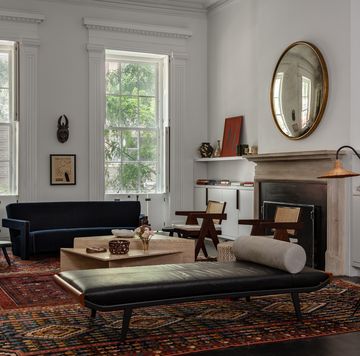If you're a fan of the gorgeous rooms featured on CBS' The Good Wife, you're not alone. From Alicia Florrick's sophisticated Chicago apartment to the myriad stately law offices, set decorator Beth Kushnick has become a celebrity in her own right with dedicated groupies who follow her on Twitter to find out more about the eye-catching decor items they see on the show. (She also wrote a popular blog about the show's sets through 2012.) Because she must shop weekly to furnish new rooms and update existing spaces for each season's 22 episodes, she heads to the same stores us "regular" people do to find easily accessible and stylish furnishings to bring back to the sets.
One of only about 50 set decorators on the East Coast, Kushnick recently decided to take her specialized craft mainstream, launching her own collection of 33 classic go-to pieces, available at Wayfair, Wal-Mart, and Amazon. Her collection includes artwork, small decor items, frames, lamps, accent tables, and a desk — inspired by the one Diane Lockhart sits at on The Good Wife — and she also works with Mitchell Gold and Bob Williams to develop The Good Wife Collection of furniture, which offers exact replicas of pieces seen on the show.
Here, Kushnick shares her step-by-step tricks for giving any room a professional designer's touch.
1. Do your research.
"In pre-production, we get our script, break it down, and make our lists of what we need," Kushnick says of the set decorating process on The Good Wife. "In your 'pre-production,' you can do your research and go online and take a look at [what's out there]. Buy a few magazines, start to pull tear sheets, and collect your paint swatches."
2. Make a decorating workbook.
"Make yourself a workbook that you've developed with your research and shop with it," Kushnick says. Reference it often as a guide for buying items in your color palette and decor style.
If you have an estate sale or flea market piece you want to incorporate into your room, this is also the time to think about how you can personalize it to make it yours. "In Alicia's dining room, I wallpapered the back of the antique breakfront with this great Ralph Lauren paisley wallpaper," Kushnick says. "It was expensive, but I only needed two rolls of it."
3. Buy the first item to set the tone of the room.
"The next step for us at The Good Wife is to go to a prop house or to a store and start to buy," Kushnick says. "Sometimes the first item I buy is the smallest item in the whole room, but it's just something I'm drawn to."
"This first item should be in your truest comfort zone, or something that speaks to the truest part of your personality or character," Kushnick says. "If what you desire is a cushy comfortable room, then maybe your first item should be that cushy chair. If you want your family history in the room, maybe that 'item' should be re-framing all your family photos that you're going to hang on the wall." For Alicia's dining room on The Good Wife, Kushnick first chose the botanical prints and built the room around the resulting gallery wall of artwork.
4. Get out the tape measure.
"Look into the practical things [you'll need], like ordering a new mattress for a bedroom, appliances if it's a kitchen, a sofa for a living room, or investing in things like more upscale window treatments," Kushnick says. "Figure out what items might come with size issues and where you have to think with the tape measure."
Don't expect to buy all your large furniture pieces at one store, either. "Sometimes people think they're just going to do one-stop shopping, which is how you fall into the trap of buying a set," Kushnick says. "Unfortunately, as much as it's helped that [furniture is] so accessible online, you become a product of the store that you're shopping from because you're being given the message, 'This is a set. This has to be together.' So I really try to get people to be more open to mixing styles, which brings more life into a room."
5. Don't push all your furniture up against the walls.
Next, get those big pieces delivered and installed in the right places, Kushnick says. "A lot of people have garnered bad habits, like plastering all of the furniture up against the walls," she says. " In my industry you see things from many different camera angles and I encourage people to think about different angles in their homes, too."
"Once you break that habit, you start to find areas for special moments," Kushnick says. "Start to think about the little corners and blank spaces that go way beyond a sofa and end tables. Adding another layer of furnishings breaks up the room." Perhaps you float the sofa so there's room for a console table against its back with a statement chair that can now have a beautiful view out the window, Kushnick says, or you can tuck two ottomans underneath some artwork.
6. Change the paint color.
Next, consider a change of paint — and don't be afraid to go bold. "Nobody would have thought about doing their dining room in the eggplant color that we've done in Alicia's home," Kushnick says, "but that's why people have responded to it — it's not something that they might think about doing on their own. So, my advice is [to] take the risk."
7. Live with your choices — then rearrange.
Push pieces around the room after living with them for a few days. "When they're decorating, people tend to not think about what their needs are within the space. Do you live in that space mostly at night when you come home from work? Do you have needs for better lighting? The more you allow yourself to really live in the space, the more these things come up and you can answer your own questions."
Whether dressing a set or designing a home, Kushnick literally sits in all the furniture in the room and rearranges items until the room works from every perspective. "I don't know going in [to a scene on The Good Wife] whether the director is going to place the actors on the sofa or around the table or standing up, so I scan the whole room to consider what everybody's viewpoint is going to be," she says.
8. Develop the top layer.
Then, as a last step, layer in mementos, things that speak to you, or items that simply give you joy. "It's always good to do a top layer that feels alive, like great silk flowers or plants, something that brings the outside in," Kushnick says.
Kushnick suggests collecting a small arsenal of linens, picture frames, and small decorative items to create a top layer you can change seasonally or move from room to room. "People are shy about allowing their spaces to really express themselves," she says, "so I'm always encouraging them to go out on a limb."
"Of course, I have a massive shop of things to pull from, but with so many styles being accessible at a low price from major retailers, like HomeGoods, it's easy to find affordable, decorative items," Kushnick says. "Switch them up during different seasons or whenever you're inspired."



